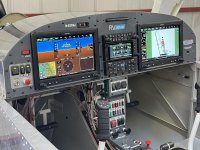RV-12ers
I have hung the Rotax 912-ULS engine. Although I have followed the KAI to this point. What modifications can be made prior to FAA/DAR inspection. I am confused about:
1. LSA vs. ELSA
2. Is there a difference between armature built and experimental with respect to the RV-12
3. If so, what are the differences.
4. Are any modifications before the build is compete authorized?
5. I am considering using a different fastener system for the cowling piano hinge vs. Skybolt/quarter turn fasteners.
Have a a great weekend.
I have hung the Rotax 912-ULS engine. Although I have followed the KAI to this point. What modifications can be made prior to FAA/DAR inspection. I am confused about:
1. LSA vs. ELSA
2. Is there a difference between armature built and experimental with respect to the RV-12
3. If so, what are the differences.
4. Are any modifications before the build is compete authorized?
5. I am considering using a different fastener system for the cowling piano hinge vs. Skybolt/quarter turn fasteners.
Have a a great weekend.





